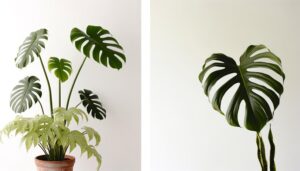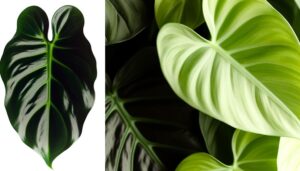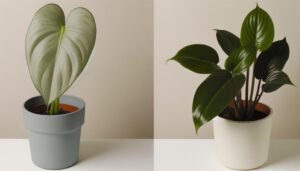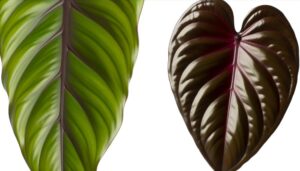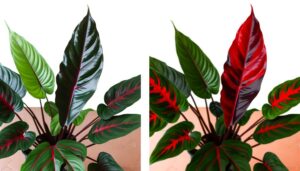Philodendron Pastazanum Vs Gloriosum: Key Differences!
Philodendron pastazanum and Philodendron gloriosum, both in the Araceae family, exhibit distinct morphological traits. P.
pastazanum’s large, heart-shaped leaves are smooth and glossy with pronounced venation, while P. gloriosum features elongated, velvety leaves adorned with prominent white veins.
The pastazanum forms a compact, clumping structure with short internodes, contrasting with the gloriosum’s sprawling, creeping growth habit with extended internodes. Both species thrive in bright, indirect light and require regular watering cycles of 7-10 days.
For optimal growth, understanding their aesthetic and physiological nuances is essential. Explore further to differentiate these enchanting species in detail.
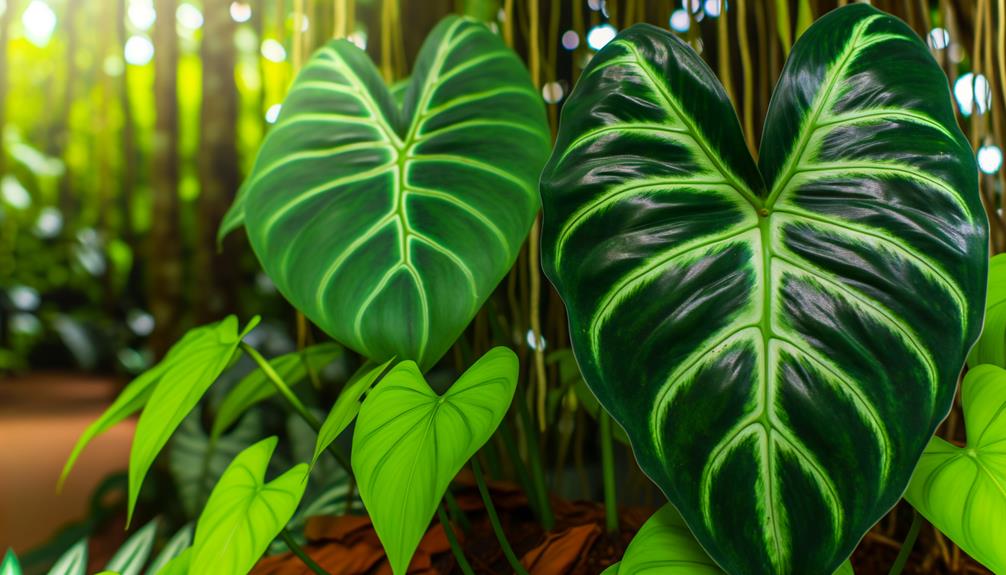
Comparison of Philodendron Pastazanum and Philodendron Gloriosum
| Feature | Philodendron Pastazanum | Philodendron Gloriosum |
|---|---|---|
| Common Name | Philodendron Pastazanum | Philodendron Gloriosum |
| Botanical Name | Philodendron pastazanum | Philodendron gloriosum |
| Leaf Appearance | Large, heart-shaped, glossy green leaves | Large, heart-shaped, velvety leaves with prominent white veins |
| Growth Habit | Creeping, crawling plant | Creeping, crawling plant |
| Light Requirements | Bright, indirect light | Bright, indirect light |
| Watering Needs | Moderate, allow the top inch to dry out | Moderate, allow the top inch to dry out |
| Humidity Preference | Medium to high humidity | High humidity |
| Temperature Tolerance | 65-80°F (18-27°C) | 65-80°F (18-27°C) |
| Soil Type | Well-draining, aroid mix | Well-draining, aroid mix |
| Fertilization | Monthly during growing season | Monthly during growing season |
| Propagation Methods | Rhizome division | Rhizome division |
| Pest Susceptibility | Spider mites, mealybugs, aphids | Spider mites, mealybugs, aphids |
| Toxicity | Toxic to pets and humans | Toxic to pets and humans |
Origin and History

Although both Philodendron pastazanum and Philodendron gloriosum belong to the Araceae family, their origins and historical pathways reveal distinct geographical and ecological adaptations.
Philodendron pastazanum is native to the tropical rainforests of Ecuador, specifically in the Pastaza province, which explains its preference for humid, shaded environments.
Conversely, Philodendron gloriosum hails from the diverse ecosystems of Colombia, thriving in regions with well-drained soils and partial sunlight.
The dissimilarities in their native habitats have influenced their distinct morphological features and growth patterns. The evolutionary divergence of these species underscores the adaptive radiation within the Araceae family, highlighting the significance of geographical distribution in the development of plant traits.
Understanding their origins is essential for effective cultivation and conservation practices.
Leaf Shape and Size
The distinct geographical origins of Philodendron pastazanum and Philodendron gloriosum are reflected in their leaf morphology. P. pastazanum exhibits large, heart-shaped leaves that can reach up to 60 cm in length. These leaves are known for their smooth, glossy surface and pronounced venation, giving them a striking appearance.
On the other hand, P. gloriosum features velvety, ovate leaves with prominent white veins. The leaves of P. gloriosum are characterized by their soft, velvety texture, complemented by contrasting, conspicuous white veins, enhancing their visual appeal.
Both species demonstrate unique adaptations that are indicative of their respective ecological niches. These characteristics offer botanists and horticulturists valuable insights into the diversity within the Philodendron genus.
Growth Habit
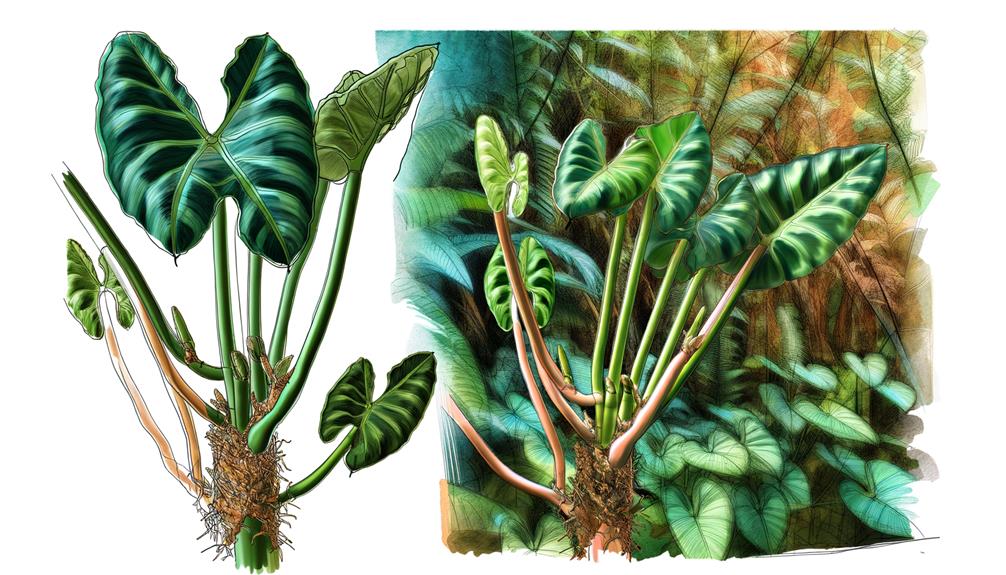
Philodendron pastazanum and Philodendron gloriosum display distinct growth habits, with P. pastazanum typically forming a compact, clumping structure, while P. gloriosum tends to exhibit a sprawling, creeping growth pattern. P. pastazanum’s compact habit is characterized by its short internodes and dense foliage arrangement, making it ideal for confined spaces.
In contrast, P. gloriosum features elongated internodes and a vining habit, necessitating horizontal space for best growth.
| Aspect | Philodendron pastazanum | Philodendron gloriosum |
|---|---|---|
| Growth Structure | Compact, clumping | Sprawling, creeping |
| Internode Length | Short | Long |
| Foliage Arrangement | Dense | Spaced |
Understanding these growth habits aids in selecting appropriate environments and care practices for each species, promoting their unique aesthetic and robust health.
Light Requirements
Both Philodendron pastazanum and Philodendron gloriosum thrive in bright, indirect light, mimicking the dappled sunlight of their native understory habitats. These aroid species, originating from tropical rainforests, require a lighting environment that avoids direct sun exposure, which can scorch their leaves.
Ideal light conditions involve positioning these plants near east or north-facing windows, where they receive filtered light. Artificial grow lights can supplement natural light, maintaining a Photosynthetically Active Radiation (PAR) range of 100-200 µmol/m²/s. Insufficient light can lead to etiolation, characterized by elongated, weak stems and diminished leaf size.
Conversely, excessive light intensity may inhibit chlorophyll production, resulting in chlorosis. Therefore, achieving a balanced light regime is essential for the physiological health and aesthetic appeal of both species.
Watering Needs
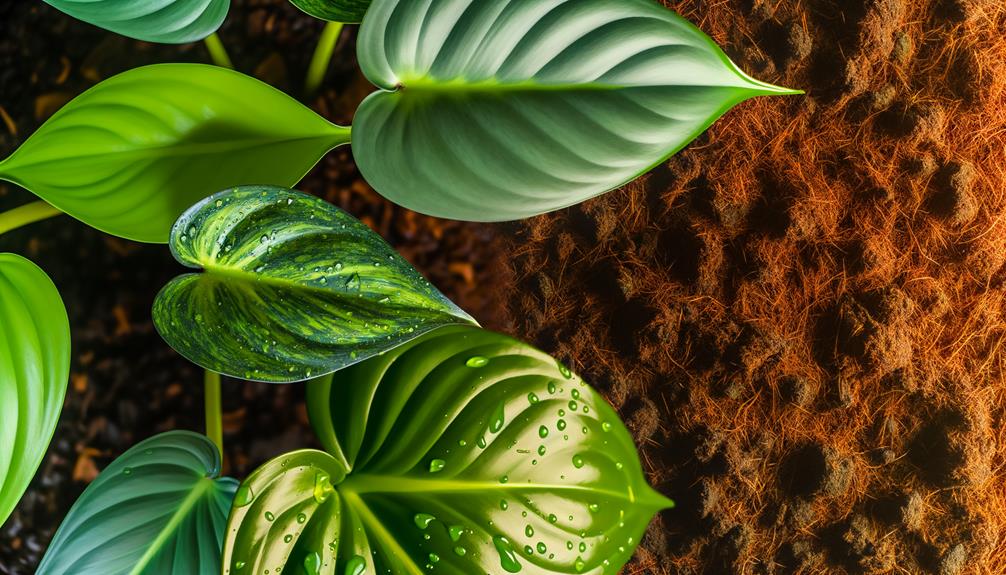
Ideal hydration for Philodendron pastazanum and Philodendron gloriosum requires a thorough yet infrequent watering routine, ensuring that the substrate stays moderately moist but never saturated. These tropical species need careful attention to their hydration needs to prevent root rot and other moisture-related issues.
The following guidelines are crucial for peak plant health:
- Watering Frequency: Water every 7-10 days during the growing season, reducing frequency in inactive periods.
- Water Quality: Use filtered or rainwater to avoid chlorine and hard minerals that can harm roots.
- Drainage: Make sure pots have sufficient drainage holes to prevent water buildup.
- Moisture Monitoring: Use a moisture meter to consistently assess substrate wetness and avoid excessive watering.
Adherence to these practices will promote strong growth and lush foliage.
Soil Preferences
Ensuring perfect hydration leads naturally to the significance of selecting a well-ventilated, nutrient-rich substrate that fosters strong root development and prevents compaction for Philodendron pastazanum and Philodendron gloriosum.
Both species thrive in a soil mix comprising a blend of orchid bark, sphagnum peat moss, and perlite, providing the necessary aeration and drainage.
This mixture simulates their natural epiphytic environment, ensuring oxygenation of the root zone while retaining sufficient moisture. Incorporating charcoal enhances microbial activity and nutrient availability, essential for best growth.
Additionally, a pH range of 5.5 to 6.5 is recommended, aligning with their preference for slightly acidic conditions. Maintaining these soil characteristics is optimal for preventing root rot and promoting vigorous plant health.
Temperature and Humidity
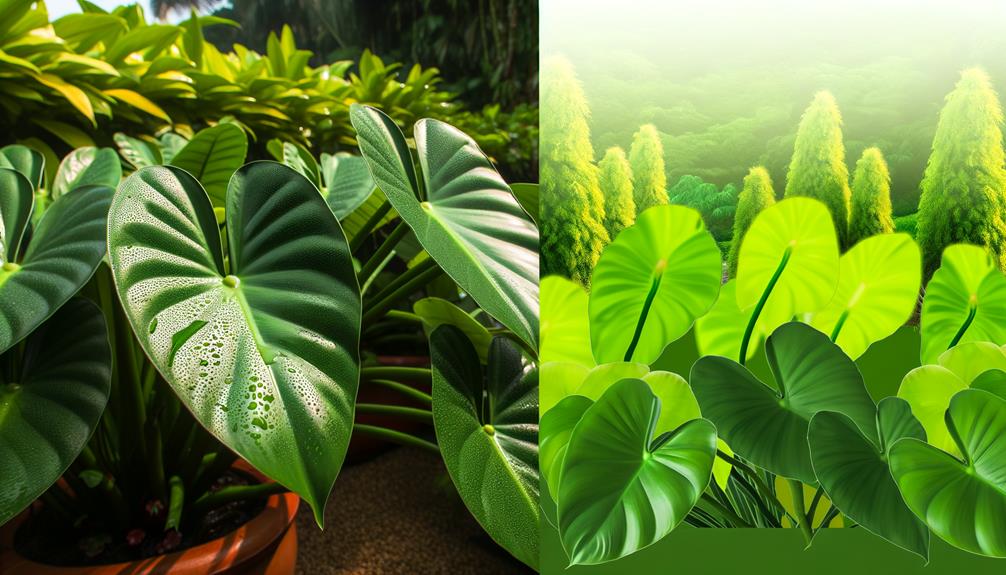
Maintaining an ideal temperature range between 18-24°C (65-75°F) and a relative humidity of 60-80% is crucial for the physiological processes and overall health of Philodendron pastazanum and Philodendron gloriosum. These tropical species thrive in microclimates that mimic their native environments.
Enhancing their growth and well-being requires careful attention to environmental conditions:
- Temperature Stability: Fluctuations outside the ideal range can stress the plants, affecting leaf development and overall vigor.
- Humidity Levels: Consistent humidity aids in nutrient absorption and prevents desiccation of foliage.
- Ventilation: Adequate air circulation mitigates fungal growth, which can thrive in humid settings.
- Monitoring: Utilize hygrometers and thermometers to maintain optimal conditions, ensuring plant health and resilience.
Understanding these parameters promotes the sustainable cultivation of these exquisite species.
Fertilizer Needs
Proper fertilization strategies are crucial for the best growth of Philodendron pastazanum and Philodendron gloriosum, necessitating a balanced nutrient regimen to support their metabolic requirements.
Both species benefit from a fertilization schedule incorporating a balanced, water-soluble fertilizer with an N-P-K ratio of 20-20-20. It is recommended to dilute the fertilizer to half-strength to prevent nutrient burn and apply bi-weekly during the active growing season.
Micronutrients such as magnesium (Mg), iron (Fe), and calcium (Ca) are essential for chlorophyll synthesis and cellular function. Organic options like compost tea or worm castings can enhance soil microbiota, promoting root health.
Monitoring for signs of over-fertilization, such as leaf tip burn, ensures the best nutrient absorption and plant health.
Pests and Diseases
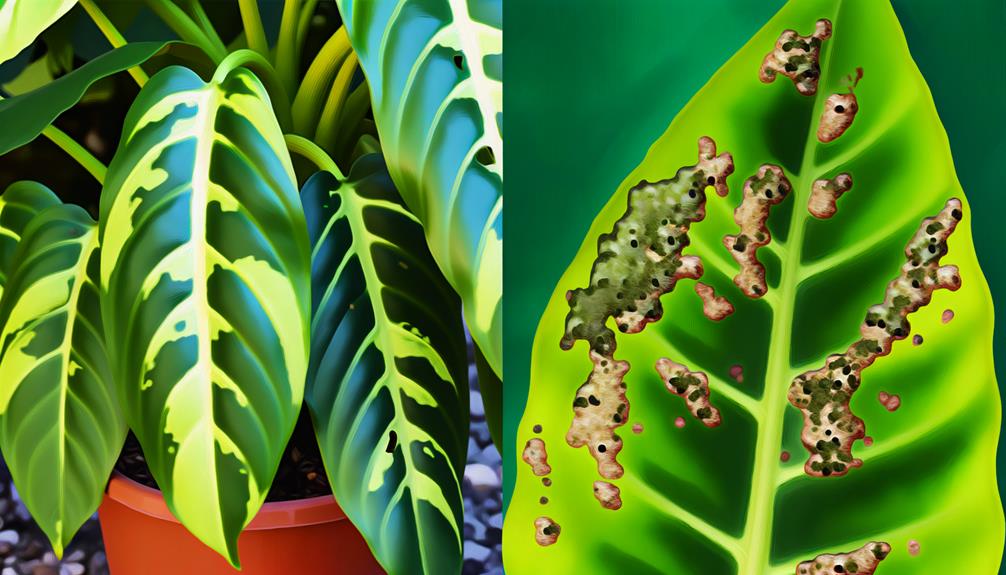
Philodendron pastazanum and Philodendron gloriosum are susceptible to several pests and diseases, including spider mites (Tetranychidae), mealybugs (Pseudococcidae), and bacterial leaf spot caused by Xanthomonas campestris. Effective management requires vigilance and appropriate interventions to maintain plant health.
Key measures include:
- Spider Mites (Tetranychidae): Regularly inspect under leaves for fine webbing and stippling; employ miticides or neem oil treatments.
- Mealybugs (Pseudococcidae): Identify by their cotton-like masses on stems; use insecticidal soap or alcohol-based sprays.
- Bacterial Leaf Spot (Xanthomonas campestris): Remove infected leaves promptly and apply copper-based fungicides.
- General Sanitation: Maintain high hygiene standards by cleaning tools and isolating new plants to prevent infestations.
Such practices are fundamental for preserving the health of these philodendron species.
Propagation Methods
Propagating Philodendron pastazanum and Philodendron gloriosum typically involves vegetative methods such as stem cuttings and division, ensuring genetic uniformity and maintaining desirable phenotypic traits.
Stem cuttings are taken from mature, healthy plants, confirming each cutting includes at least one node. These cuttings are then placed in a suitable medium, such as sphagnum moss, to promote root formation.
Division involves separating the plant at its natural growth points, which is particularly effective for well-established specimens. This method guarantees each division has an adequate root system and foliage to sustain growth.
Both methods are preferred for their ability to produce clonal offspring, preserving the unique characteristics of the parent plant.
| Method | Advantages | Requirements |
|---|---|---|
| Stem Cutting | Clonal reproduction | Healthy stem with nodes |
| Division | Immediate establishment | Mature plant with multiple growth points |
| Sphagnum Moss | Ideal for rooting cuttings | Consistent moisture |
| Water | Visible root growth | Frequent water changes |
| Soil | Direct establishment in growth medium | Well-draining substrate |
Aesthetic Appeal
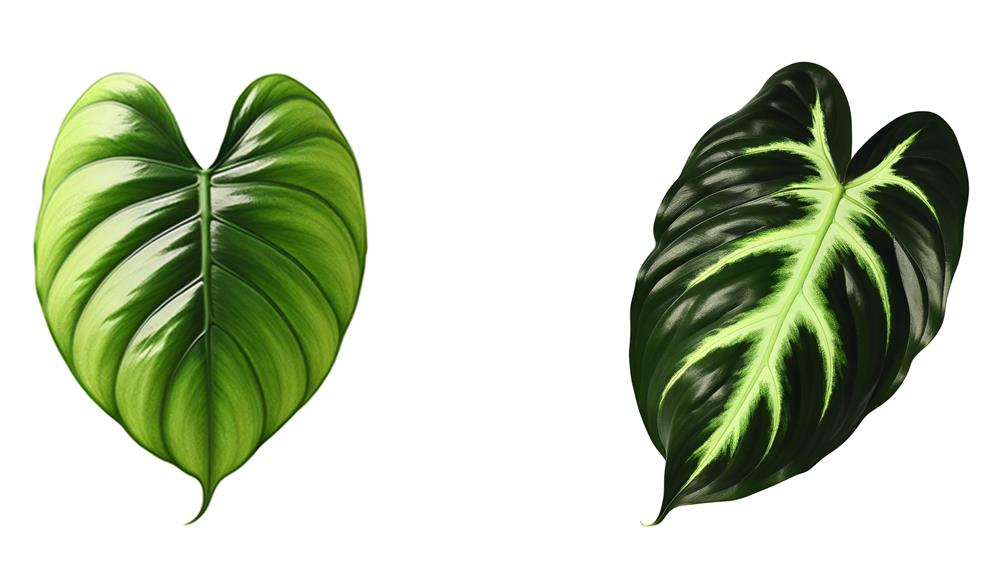
The aesthetic appeal of Philodendron pastazanum and Philodendron gloriosum is primarily distinguished by their unique leaf morphology and surface characteristics.
Philodendron pastazanum is noted for its cordate, deeply veined leaves that exhibit a glossy texture, while Philodendron gloriosum features velvety, sagittate leaves with prominent white venation.
These differences in leaf shape, coloration, and texture greatly influence their visual impact and suitability for various decorative applications.
Leaf Shape Differences
A key distinction between Philodendron pastazanum and Philodendron gloriosum lies in their leaf morphology. Pastazanum exhibits ovate, cordate leaves resembling a heart shape, while gloriosum displays more elongated, sagittate shapes akin to an arrowhead.
The specific differences are as follows:
Leaf Shape:
- Philodendron pastazanum: Ovate, cordate leaves, resembling a heart shape.
- Philodendron gloriosum: Elongated, sagittate leaves, akin to an arrowhead.
Leaf Apex:
- Pastazanum: Rounded apex.
- Gloriosum: Acuminate apex.
Leaf Base:
- Pastazanum: Deeply cordate base.
- Gloriosum: Slightly cordate base.
Leaf Size:
- Pastazanum: Generally broader.
- Gloriosum: Typically longer.
These morphological characteristics contribute significantly to their distinct aesthetic appeal, making each species uniquely desirable for different horticultural preferences.
Color and Texture
Color and texture distinctions between Philodendron pastazanum and Philodendron gloriosum greatly enhance their ornamental value. Pastazanum leaves exhibit a glossy, deep green surface, while gloriosum leaves feature a velvety texture and prominent white venation.
Philodendron pastazanum (syn. Philodendron sodiroi) leaves possess a smooth, lustrous epidermis that reflects light, accentuating its rich, monochromatic green hue.
In contrast, Philodendron gloriosum leaves exhibit a matte finish due to their tomentose surface, which diffuses light and emphasizes the strikingly contrasting white venation against the dark green lamina.
The gloriosum’s texture adds a tactile dimension, enhancing its visual appeal. These differences in color and texture significantly contribute to the plants’ aesthetic appeal, making them highly sought after for indoor decoration and botanical collections.
Philodendron Gloriosum X Pastazanum
The Philodendron Gloriosum x Pastazanum is a hybrid that combines the distinctive features of both parent species.
Appearance:
- Leaves: This hybrid typically features large, heart-shaped leaves with a velvety texture, combining the prominent veining and velvety appearance of Gloriosum with the rounded, lush green leaves of Pastazanum.
- Growth Habit: Primarily a crawling or creeping plant, similar to its Gloriosum parent, making it suitable for ground coverage or large containers.
Care:
- Light: Prefers bright, indirect light. Direct sunlight should be avoided as it can cause leaf burn.
- Water: Maintain consistently moist soil, allowing the top inch to dry out between waterings. Overwatering can lead to root rot.
- Humidity: High humidity levels are ideal. Regular misting or using a humidifier can help achieve this.
- Soil: A well-draining, aerated soil mix is crucial. A blend of peat, perlite, and orchid bark is recommended to provide proper drainage and aeration.
This hybrid is valued for its striking foliage and relatively easy care, making it a popular choice among plant enthusiasts.
Conclusion
In summation, Philodendron pastazanum and Philodendron gloriosum, with their distinctive leaf morphologies and growth habits, embody the quintessence of botanical splendor.
While P. pastazanum’s heart-shaped leaves and compact growth offer an intimate elegance, P. gloriosum’s expansive foliage and creeping rhizomes exude grandiosity.
Both species demand specific light, water, and nutrient conditions, yet each presents a unique tableau of verdant beauty.
These philodendrons, like verdant masterpieces, transform any space into a lush, tropical oasis, enchanting the observer with their botanical artistry.

